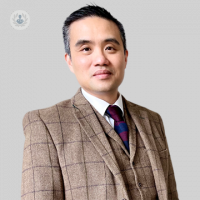Exploring the SPAIRE technique in hip replacement
Written by:In his latest online article, Professor Paul Lee gives us his insights into The SPAIRE technique. He talks about what the SPAIRE technique is in hip replacement surgery, the benefits, what makes it innovative and the ideal candidates.

What is the SPAIRE technique in hip replacement surgery?
The SPAIRE (Spare Piriformis And Internus, Repair Externus) hip replacement technique is a modern approach in orthopaedic surgery. It utilises a muscle-sparing mini-posterior approach, minimising tendon and muscle damage around the hip joint. This method involves dividing and then repairing only the obturator externus tendon, while preserving other vital tendons and muscles. This approach helps maintain the natural anatomy and biomechanics of the hip, leading to quicker post-operative recovery and improved functional outcomes. Patients can exercise their hip through a full range of motion immediately after surgery due to its on-table stability. Notably, the SPAIRE technique imposes no post-operative restrictions, further speeding up rehabilitation and returning to normal functionality.
Additionally, the SPAIRE procedure involves using modern implants and surgical instruments, which are designed using the latest advancements in medical engineering. This ensures optimal compatibility, durability, and functionality, enhancing the effectiveness and longevity of the procedure.
What are the benefits of choosing the SPAIRE technique for hip replacement?
The SPAIRE (Spare Piriformis And Internus, Repair Externus) technique for hip replacement offers several benefits:
- Muscle-sparing approach: It uses a mini-posterior approach that minimises tendon and muscle damage around the hip joint. Only the obturator externus tendon is divided and repaired, sparing other vital tendons and muscles.
- Improved post-operative recovery: This approach accelerates recovery, promoting quicker return to mobility.
- Enhanced functional outcomes: SPAIRE maintains the natural anatomy and biomechanics of the hip, allowing full range of motion immediately post-surgery, leading to better function and mobility.
- No post-operative restrictions: There are no post-operative restrictions with the SPAIRE technique, which speeds up rehabilitation and facilitates a rapid return to normal functionality.
What makes the SPAIRE hip replacement technique innovative in orthopaedic surgery?
The SPAIRE (Spare Piriformis And Internus, Repair Externus) hip replacement technique is innovative in orthopaedic surgery due to several key factors:
Muscle-sparing approach: SPAIRE uses a muscle-sparing mini-posterior approach, focusing on minimising tendon and muscle damage around the hip joint. It targets only the obturator externus tendon for division and subsequent repair while preserving other tendons and muscles. This approach accelerates post-operative recovery and promotes quicker return to mobility.
Maintaining natural anatomy and biomechanics: SPAIRE is dedicated to preserving the natural anatomy and biomechanics of the hip, allowing patients to exercise their hip through a full range of motion immediately post-surgery. This contributes to improved functional outcomes and mobility.
No post-operative restrictions: The technique imposes no post-operative restrictions, facilitating a rapid return to normal functionality and a smooth recovery process.
Modern implants and instruments: SPAIRE uses contemporary implants and surgical instruments designed with the latest advancements in medical engineering. This enhances the compatibility, durability, and functionality of the procedure, augmenting its effectiveness and longevity.
Overall, the SPAIRE technique represents a significant advancement in hip replacement surgery, focusing on reducing tissue damage, preserving natural hip mechanics, and enhancing post-operative recovery and functionality.
Who are the ideal candidates for the SPAIRE hip replacement procedure?
- Active Individuals: Those who lead an active lifestyle and wish to return to their activities quickly after surgery. The SPAIRE technique's quick recovery time is particularly beneficial for this group.
- Patients seeking minimal post-operative restrictions: Since SPAIRE does not impose the typical post-operative restrictions associated with traditional hip replacement surgery, it's ideal for patients who desire a more immediate return to their normal daily activities.
- Individuals with strong muscle mass: The technique may be more beneficial for individuals with a muscular build, especially since it focuses on sparing muscle and tendon structures around the hip joint.
- Patients with specific hip joint conditions: Those who have certain conditions affecting the hip joint, where preserving as much of the natural anatomy as possible is crucial, might find SPAIRE to be a suitable option.
- Patients seeking biological recovery: SPAIRE supports a more natural and biological healing process due to its muscle and tendon-sparing approach.
- Gender considerations: While the technique is suitable for all genders, certain aspects of SPAIRE might be more advantageous for males, especially when compared to other approaches like the bikini hip approach.
- Patients looking for long-term benefits: Individuals interested in a procedure that offers improved functional outcomes and longevity, aligning with advancements in medical engineering and surgical techniques.
Professor Paul Lee is an esteemed orthopaedic surgeon. You can schedule an appointment with Professor Lee on his Top Doctors profile.


